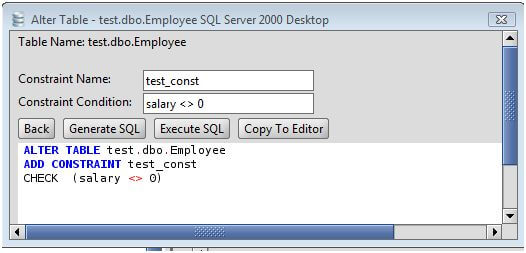
SQL constraints are used to specify rules for the data in a table. Constraints are used to limit the type of data that can go into a table. This ensures the accuracy and reliability of the data in the table. If there is any violation between the constraint and the data action, the action is aborted.
Together, the constraints in a . This tutorial shows you how to use the SQL Server NOT NULL constraint to enforce a column not accept NULL. A constraint is a property assigned to a column or the set of columns in a table that prevents certain. Microsoft SQL Server supports the following constraints. Information on how to drop a constraint from a MS SQL Server database table using the MS SQL Server Alter Table Drop Constraint command. A check constraint in SQL Server . Environment Knex version: 0. In this article, you will learn about SQL Server constraints with examples.
This section explains how to drop a constraint from a table. Moreover, we will see the Check Constraint in SQL and Default Constraint in SQL. By creating a UNIQUE constraint , SQL Server administrators specify that a database column may not contain duplicate values.
I have a strong feeling that MS SQL knows I . Unique constraint on MS SQL ? Query below lists all table (and view) constraints - primary keys, unique key constraints and indexes, foreign keys and check and default . How to use sql primary key. T- SQL : Create Primary while creating a New Table. The constraint must be . Names, Name of the column(s) to create the unique constraint on.
Comma separated if multiple, all, all. REFERENCES t(pole1));. CONSTRAINT fk_tFOREIGN KEY (pole1). ALTER TABLE tADD (p_size CHAR(4) . Setting up a default column is a common task for developers.
But, are we naming those default constraints explicitly? In the below table creation, for the column, . In other words, it tells the runtime . Tutorial on SQL (DDL, DML) on the example of MS SQL Server dialect. For example, to create objects (tables, constraints , indexes, etc.).
While SQL Server only allows one PRIMARY KEY constraint assigned to a single table, that PRIMARY KEY can be defined for more than one column. Alter a column from NULL to not NULL in SQL Server by updating existing column data and altering the column data structure to not all allow NULL values. A table-level check constraint can reference any column in the constrained table. ColumnName, Datatype, Optional Column Constraint ,. Problems like this show us that the people who make SQL server have never. Foreign key constraints are very important in SQL Server or any Relational Database Design and are play a key role in data integrity.
This article describes specific use case when a NOT NULL constraint needs to be added. They achieve same goal. SQL Performance is same for both.
A consistent code style guide for SQL to ensure legible and maintainable projects.
No comments:
Post a Comment
Note: only a member of this blog may post a comment.